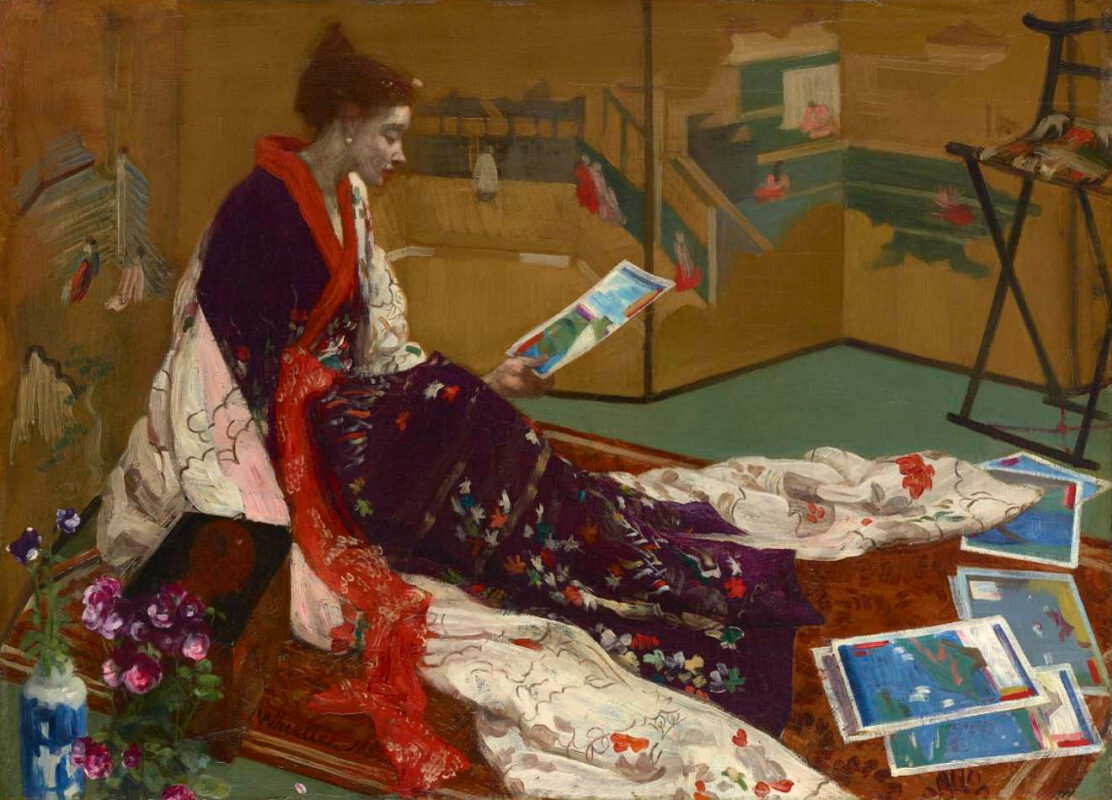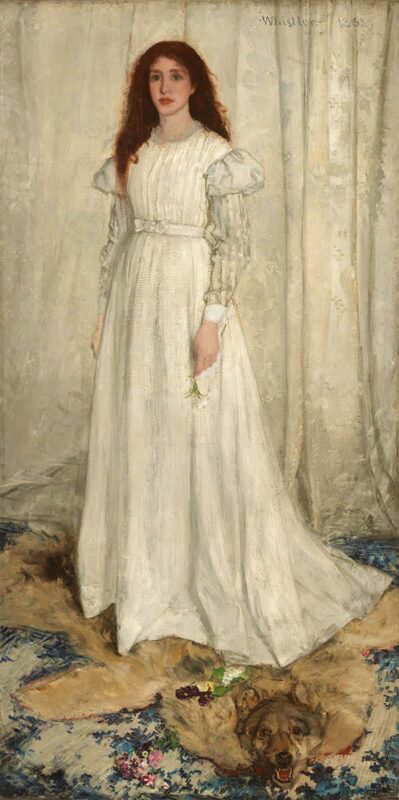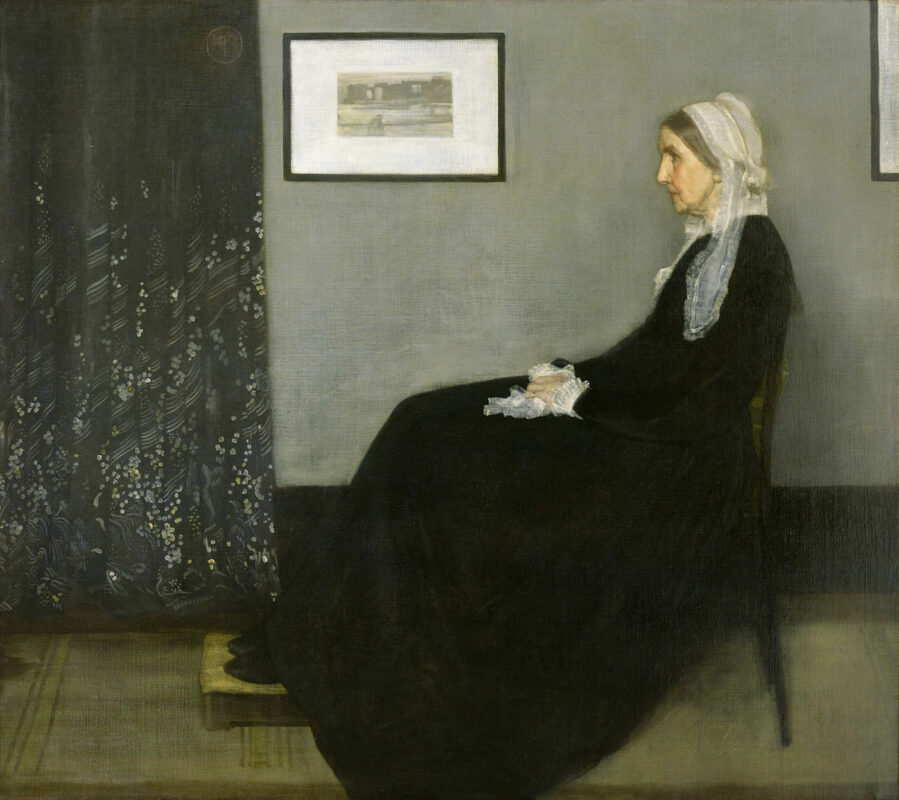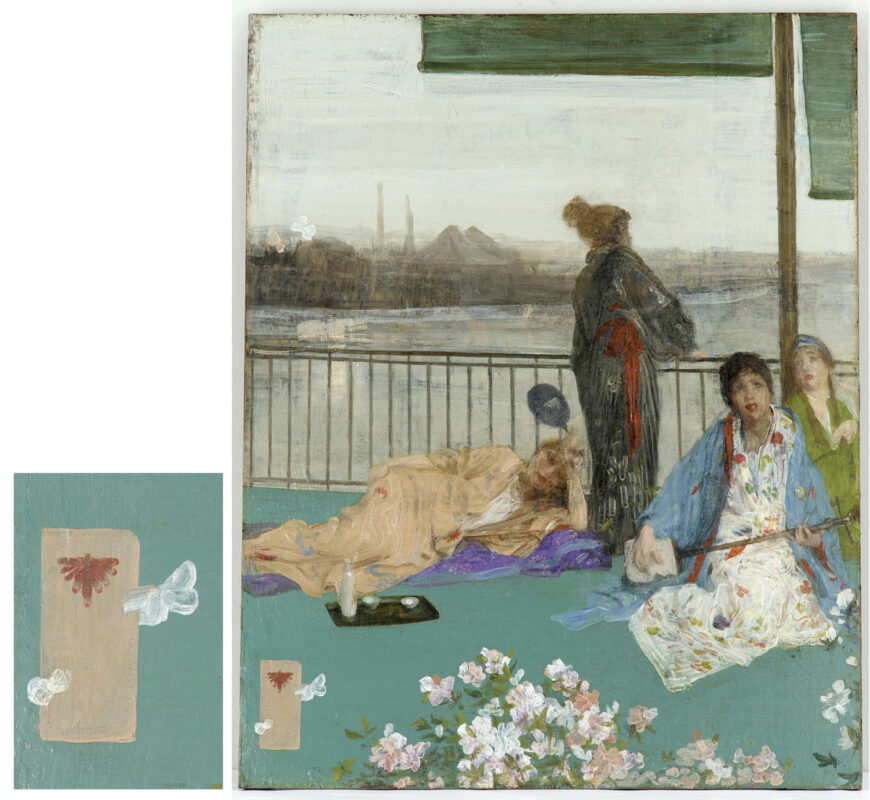What Art Movement Was Jam Whistler a Part of

James Abbott McNeill Whistler made a name for himself in nineteenth-century Europe for a daring approach to art that was equally compelling—and controversial—as his public persona. From unconventional painting names to unsolicited home renovations, here are twelve fascinating facts about the American artist who shook up the London art world and pioneered the Artful Movement.
1. James Abbott McNeill Whistler Never Returned To The States

Born to American parents in Massachusetts in 1834, James Abbott McNeill Whistler spent his early childhood in New England. By the time he was xi, however, Whistler's family had moved to Saint petersburg, Russia, where the immature artist enrolled in the Imperial University of Arts while his father worked every bit an engineer.
At his female parent's urging, he afterward returned to America to attend ministry school, simply that was brusque-lived equally he was more interested in sketching in his notebooks than learning virtually the church. Then, after a brief stint at the Usa War machine Academy, Whistler worked every bit a cartographer until he decided to pursue a career as an artist. He went on to spend time in Paris and brand his home in London.
Despite never returning to the states subsequently his youth, James Abbott McNeill Whistler is fondly revered within the American fine art history canon. In fact, much of his work is currently being preserved in American collections, including the Detroit Plant of Fine art and the Smithsonian Establishment , and his paintings accept appeared on US postal stamps .
ii. Whistler Studied And Taught In Paris

Are you enjoying this article?
Sign up to our Complimentary Weekly Newsletter
Please cheque your inbox to activate your subscription
Cheers!
Like many immature artists of his fourth dimension, Whistler rented a studio in the Latin Quarter of Paris and made friends with bohemian painters like Gustav Courbet , Éduoard Manet , and Camille Pissarro . He likewise participated in the 1863 Salon des Refusés , an exhibition for avant-garde artists whose piece of work had been rejected by the official Salon.
While James Abbott McNeill Whistler originally intended to go a serious art education in Paris, he didn't concluding long in a traditional bookish setting. Instead, when he returned to London, Whistler brought radical ideas about modern painting that scandalized academicians. He helped spread movements like Impressionism , which experimented with "impressions" of light and color, and Japonism , which popularized aesthetic elements of Japanese art and culture.
Towards the end of his career, Whistler established his ain art school in Paris. The Académie Carmen closed just two years after it opened, only many young artists, most of them American expatriates, took advantage of Whistler's eccentric mentorship.
3. The Artful Movement Was Born Thanks To Whistler's Influence

Unlike the long-held traditions upheld by Europe's prestigious academic institutions, the Artful Motion aimed to dismantle the thought that fine art has to be moralizing or even tell a story. Whistler was one of the leading artists of this new movement in London and, through his paintings and a series of popular public lectures , he helped popularize the concept of "fine art for art's sake." Artists who adopted this motto elevated aesthetic values, like brushwork and color, above any deeper pregnant, similar religious dogma or even simple narrative, in their work—a novel approach to art in the nineteenth century.
The Aesthetic Movement , and Whistler's immense artistic and philosophical contributions to it, captivated artists, craftspeople, and poets of the avant-garde and helped pave the way for various turn-of-the-century movements across Europe and America, such as Art Nouveau .
4. The Portrait Of Whistler's Mother Isn't What It Seems

Whistler is most oftentimes remembered by the portrait of his female parent, which he named Arrangement in Grey and Black No. one . The famous painting actually came well-nigh by blow. When 1 of Whistler'due south models never showed up for a sitting, Whistler asked his mother to fill up in. Whistler was notorious for exhausting his models with his perfectionistic, and thus irksome, approach to portraiture. The seated pose was adopted and then Whistler'south female parent could withstand the dozens of modeling sessions required of her.
Upon its completion, the painting scandalized Victorian era viewers, who were accustomed to overtly feminine, decorative, and moralistic depictions of motherhood and domesticity. With its ascetic composition and unsentimental mood, Arrangement in Grey and Black No. 1 could not have deviated further from platonic Victorian motherhood. As indicated by its official championship, however, Whistler never meant the painting to represent maternity at all. Rather, he thought of it foremost as an aesthetic organization of neutral tones.
Despite the artist'southward original vision, Whistler's Mother has become one of the most universally recognized and beloved symbols of motherhood today.
five. Whistler Introduced A New Method Of Naming Paintings

Like the portrait of his mother, most of Whistler's paintings are named not for their subjects, just with musical terms similar "organisation," "harmony," or "nocturne." As a proponent of the Artful Motility and "art for art's sake," Whistler was fascinated past how a painter could attempt to emulate the artful qualities of music. He believed that, like the harmonious notes of a beautiful song without lyrics, the aesthetic components of a painting could provoke the senses and evoke a feeling instead of telling a story or teaching a lesson.
Traditionally, the title of a painting would provide of import context about the subject area or the story it depicts. James Abbott McNeill Whistler used musical titles as an opportunity to direct the viewer'south attending towards the aesthetic components of his work, especially the color palette, and to bespeak the absence of whatsoever deeper significant.
6. He Popularized A New Genre Of Painting Chosen Tonalism

Tonalism was an artistic style that emerged in part due to Whistler'south influence on American landscape painters. Proponents of Tonalism utilized a subtle array of bawdy colors, soft lines, and abstracted shapes to create landscape paintings that were more atmospheric and expressive than they were strictly realistic.
Like Whistler, these artists focused on the artful, not the narrative, potential of their mural paintings and were especially drawn to night and stormy color palettes. It was actually art critics that coined the term "tonal" to make sense of the moody and mysterious compositions that dominated the American art scene in the tardily nineteenth century.
Several notable American landscape painters embraced Tonalism, including George Inness , Albert Pinkham Ryder , and John Henry Twatchman . Their experiments with Tonalism preceded American Impressionism , a movement that ultimately became much more popular.
7. Whistler Signed Paintings With A Butterfly

Always eager to distinguish himself from the crowd, Whistler invented a unique butterfly monogram with which to sign his art and correspondence instead of a traditional signature. The butterfly insignia underwent several metamorphoses over the course of his career.
James Abbott McNeill Whistler began with a stylized version of his initials that developed into a butterfly, whose torso formed the "J" and wings formed the "West." In certain contexts, Whistler would mischievously add a scorpion stinger tail to the butterfly. This was said to embody the contradictory qualities of his delicate painting style and his combative personality.
The iconic butterfly insignia, and the way Whistler cleverly and prominently integrated it into his aesthetic compositions, was heavily influenced past the flat, stylized characters commonly found on Japanese woodblock prints and ceramics.
8. He Spent Nights On A Gunkhole To Get together Inspiration

James Abbott McNeill Whistler lived within view of the River Thames in London for much of his career, so it is no surprise that it inspired many paintings. The moonlight dancing across the h2o, the dumbo fumes and shimmering lights of the apace industrializing city, and the cool, muted colors of nighttime all inspired Whistler to create a serial of moody landscape paintings chosen Nocturnes .
Walking along the riverbank or rowing out into the water on a gunkhole, Whistler would spend hours alone in the night committing his various observations to memory. By the calorie-free of day, he would then paint the Nocturnes in his studio, using layers of thinned paint to loosely suggest the presence of shorelines, boats, and distant figures.
Critics of Whistler'south Nocturnes complained that the paintings seemed more than like crude sketches than fully realized works of art. Whistler countered that his artistic aim was to create a poetic expression of his observations and experiences, not a highly finished, photographic rendering of a specific place.
9. James Abbott McNeill Whistler Was A Prolific Etcher

James Abbott McNeill Whistler was also famous during his lifetime for his remarkable etching skills, which he first developed during his brief tenure making maps. In fact, one Victorian-era writer said of Whistler'southward etchings, "At that place are some who set him beside Rembrandt, perhaps above Rembrandt, as the greatest main of all time." Whistler fabricated several etchings and lithographs over the course of his career, including portraits, landscapes, street scenes, and intimate street scenes, including a deputed series he created in Venice, Italy.
Like his painted Nocturne landscapes, Whistler's etched landscapes feature strikingly simple compositions. They likewise have a tonal quality to them, which Whistler expertly achieved past experimenting with line, shading, and inking techniques instead of paint colors.
ten. Whistler Renovated A Room Without The Homeowner's Permission

Harmony in Blue and Gold: The Peacock Room is a quintessential example of Artful Movement interior design. Whistler labored on the project for several months, sparing no effort or expense in the room'due south lavish transformation. Nevertheless, Whistler was never actually commissioned to do any of it.
The Peacock Room was originally a dining room belonging to Frederick Leyland , a wealthy shipowner, and friend of the artist. When Leyland asked Whistler for advice about pigment colors in his London residence, Whistler took it upon himself to transform the entire room while its owner was away on business. He covered every inch of the space with elaborate gilded peacocks, jewel-toned blue and dark-green paint, and decorative objects from Leyland's collection—including a painting by Whistler , which took eye stage in the redesign.
When Leyland returned abode and Whistler demanded an exorbitant fee, the human relationship between the two men was ruined beyond repair. Fortunately, the Peacock Room was preserved and remains on display at the Freer Gallery of Art in Washington, DC .
11. One of Whistler's Paintings Sparked A Lawsuit

In response to Nocturne in Blackness and Golden—The Falling Rocket , art critic John Ruskin accused Whistler of "flinging a pot of paint in the public'southward face." Whistler'due south reputation was damaged by the negative review, and then he sued Ruskin for libel.
The Ruskin vs. Whistler trial fueled a public debate on what it means to be an artist. Ruskin argued that the shockingly abstract and painterly Falling Rocket was unworthy of being chosen art and that Whistler's apparent lack of effort on it made him unworthy of existence called an artist. Whistler, on the other manus, insisted that his work should be valued for "the noesis of a lifetime" rather than the number of hours he spent painting it. While Falling Rocket only took Whistler 2 days to pigment, he spent many years honing the paint-splattering techniques and forward-thinking philosophies that informed its creation.
James Abbott McNeill Whistler ultimately won the instance but was only awarded a single farthing in damages. The enormous legal costs forced him to declare bankruptcy.
12. James Abbott McNeill Whistler Had An Outrageous Public Persona

James Abbott McNeill Whistler pushed the boundaries of personality just as much every bit he pushed the boundaries of Victorian-era art. He was notorious for cultivating and living upwards to an over-the-top public persona, successfully branding himself long before it was pop for celebrities to do so.
An obituary published after Whistler's decease described him as an "extremely irritating controversialist" whose "sharp tongue and caustic pen were always gear up to prove that the human being—specially if he happened to paint or write—who did not fall into line as a worshipper was an idiot or worse." Indeed, afterwards the infamous Ruskin vs. Whistler trial, Whistler published a book titled The Gentle Art of Making Enemies to ensure he got the final give-and-take in the very public fence about his value as an artist.
Today, over one hundred years later on his decease, James Abbott McNeill Whistler'due south value and impact equally an artist is clear. While the leader of the Artful Move attracted equally many naysayers every bit he did followers during his lifetime, his daring innovations in painting and cocky-promotion were an important goad for European and American Modernism .
angashatevesserom.blogspot.com
Source: https://www.thecollector.com/james-abbott-mcneill-whistler-a-leader-of-the-aesthetic-movement-12-facts/